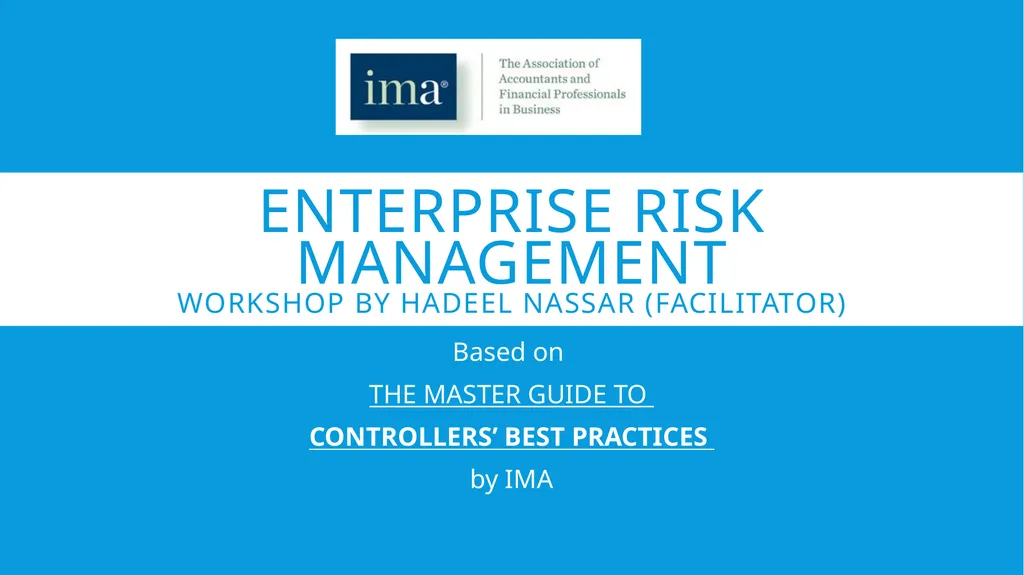Enterprise Risk MANAGEMENT workshop by Hadeel
Author : aaron | Published Date : 2025-06-23
Description: Enterprise Risk MANAGEMENT workshop by Hadeel NASSAr Facilitator Based on THE MASTER GUIDE TO CONTROLLERS BEST PRACTICES by IMA Enterprise Risk Management is a process effected by entitys board of directors management and other
Presentation Embed Code
Download Presentation
Download
Presentation The PPT/PDF document
"Enterprise Risk MANAGEMENT workshop by Hadeel" is the property of its rightful owner.
Permission is granted to download and print the materials on this website for personal, non-commercial use only,
and to display it on your personal computer provided you do not modify the materials and that you retain all
copyright notices contained in the materials. By downloading content from our website, you accept the terms of
this agreement.
Transcript:Enterprise Risk MANAGEMENT workshop by Hadeel:
Enterprise Risk MANAGEMENT workshop by Hadeel NASSAr (Facilitator) Based on THE MASTER GUIDE TO CONTROLLERS’ BEST PRACTICES by IMA Enterprise Risk Management is a process, effected by entity's board of directors, management and other personnel, initiated in strategy setting spread across the entity, to identify the potential risk that may affect the enterprise and control the risk to be within in the entity’s risk appetite and provide reasonable assurance on the achievement of the organizational objectives. Objectives Learning Risk management in interactive session! To learn and explore: Risk management definition/s Risk main concepts (appetite, residual, inherent…etc.) Risk categories Factors that may create the risk Types of risk Risk management models Considerations Enterprise Risk management definition/s The Committee of Supporting Organizations of the Treadway Commission (COSO) defines Enterprise Risk Management as follows: Enterprise risk management is a process, effected by an entity’s board of directors, management, and other personnel, applied in strategy setting and across the enterprise, designed to identify potential events that may affect the entity, and manage risk to be within its risk appetite, to provide reasonable assurance regarding the achievement of entity objectives. ERM main concepts Now the BIG FUN Starts Risk assessment Risk response Appetite Residual Inherent Risk categories The Association of Financial Professionals (AFP) conducted a survey in October 2011. The responses came from 435 finance professionals, across North America. Financial Risk (credit, liquidity, interest rate, currency/FX) 72% Macroeconomic Risk (GDP growth, inflation) 38% Business/Operations Risk (supply chain disruptions, production interruptions, litigation, labor, outsourcing, IT) 36% External Risk (country risk, regulatory, natural disaster) 37% Commodities Risk (power and heat, crude oil & distillates, agricultures, metals) 22% Factors that may create the risk When developing a risk management plan, a controller should consider factors that may create risk, These factors are: Inadequate management reporting and monitoring Inadequate financial performance metrics Operational issues due to poor internal controls Legal and regulatory violations Incorrect financial reporting due to management overrides or fraudulent activities Excessive bad debt and inventory write-offs Internal and external fraud Breaches in confidentiality Lack of quality control Lack of business continuity plan Types of risk Operational risk Financial risk Fraud risk Market risk Credit risk Commodity risk Currency risk Project risk Technology and software risk Risk management models The Deming Cycle Risk management models ISO 31000:2009 Risk management models The committee of Sponsoring Organizations of the Treadway Commission (COSO) Enterprise Risk Management (ERM) Model Considerations Internal














